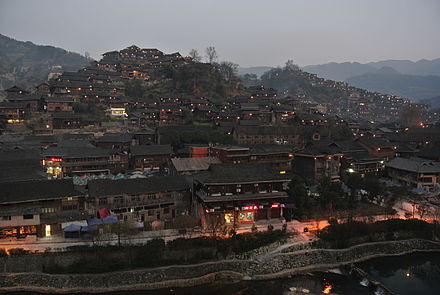Xijiang - town in Guizhou, China
 Xijiang (西江, Xījiāng) is a village in Eastern Guizhou, known as the largest Miao village in China. It bears the title 'thousand household village' (千户苗寨) and has a little over a thousand residential dwellings, which amounts to a population of over 5000, of which 99.5% are Miao.
Xijiang (西江, Xījiāng) is a village in Eastern Guizhou, known as the largest Miao village in China. It bears the title 'thousand household village' (千户苗寨) and has a little over a thousand residential dwellings, which amounts to a population of over 5000, of which 99.5% are Miao.
It is often quoted by researchers as a living fossil for the study of the Miao people's history and traditional culture. It is host to a number of festivals, particularly around the Chinese new year, where Miao from surrounding villages gather.
The dark wooden houses are laid out compactly over two adjacent spurs, at the base of which a river flows. From the entrance gate on the opposing hill, there is a spectacular view of the entire village.
The village is situated within a deep valley in the protected LeiGongshan national park, and the surrounding countryside makes for hikes ranging from short to up to a few hours, into the surrounding rice fields and forested hills.
In the last few years, a good deal of money has been invested in restoring the houses to their original appearance, in an effort to designate the village as a tourist destination. As such, the main street and riverfront area are relatively new and host lines of stalls aimed at tourist revenue. A wander through the back streets and up the hillside, however, takes you into more authentically occupied spaces.
Get in
There's a new road here from Kaili, it takes under 1 hour.
Bus schedule: Kaili - Xijiang : 0900, 1030, 1230, 1430, 1630. Xijiang - Kaili: 0730, 0830,1000, 1300, 1500. Xijiang - Leishan: 0630-1730, regular buses.
From Kaili, it is also possible to take a bus to Leishan, and then onward to Xijiang. Not including waits, the entire journey should take no more than 3 hours.
At the gate, there is a Y60 entrance fee covering your entire stay. The fee is officially Y100, but there is an automatic discount. After the public bus drops you off to pay the fee, walk to the village to find accommodation.
Get around
The village is compact and may take 15 minutes to walk along the main road from one end to the other.
See
- Daily performances - of Miao singing and dancing acts, each depicting a various tale, in the Bronze Drum dancing ground, the first at 11:30am and the next at 5pm.
- Xijiang Miao Museum (西江苗族博物馆), Old Street (古街 Gu Jie); (a short distance southeast of the Xijiang Town Government building), 26.495717990358656°, 108.16989398015242°, +86 855 3339666. 09:00-17:00. Entry fee is included in the village entrance fee 2020-09-26
Do
The village is situated within a deep valley in the protected LeiGongShan national park, and the surrounding countryside makes for hikes ranging from short to up to a few hours, into the surrounding rice fields and forested hills.
Choose from a selection of Miao traditional dresses and have your picture taken.
Buy
There are a range of items on sale, including local embroidery, Batik textiles, silverwork and other works of art.
Eat
At some guesthouses and restaurants, be greeted by an entourage of Miao women, who will hang a boiled egg enclosed in a cotton necklace, and demand that you drink a bull's horn full of 'Mijiu' or rice wine before entering the establishment.
Walking along the main road downriver, you will come to barbeque and snack vendors.
There are a smattering of restaurants, particularly at homestays. Around the two main squares, and along the main street one can easily enough find a restaurant.
Drink
Sleep
- Xijiang Yue Hotel, Neat, clean two and three bed rooms, all with bathroom. Comfortable lounge area, and restaurant/bar patio. The main reason to stay here is the view of the village on the opposing hillside, amazing both at night when the lanterns are lit, and in the mornings/afternoons (Start walking downhill from the entrance gate, and look for a new, large wooden house with 4 red lanterns hanging from the front, and three red Chinese characters posted up), +86 8553348678, +86 15870263478.
Connect
Go next
Enquire the day before about bus departure times back to Leishan, from where it is possible to get southward transport onward to Rongjiang and Congjiang, or northward to Kaili, or by local public bus or minibus to one of the other Miao villages in Leishan county, such as Langde
Xijiang, Guizhou
Timezone:MultiplePopulation:19,318Coordinates:26.50, 108.17